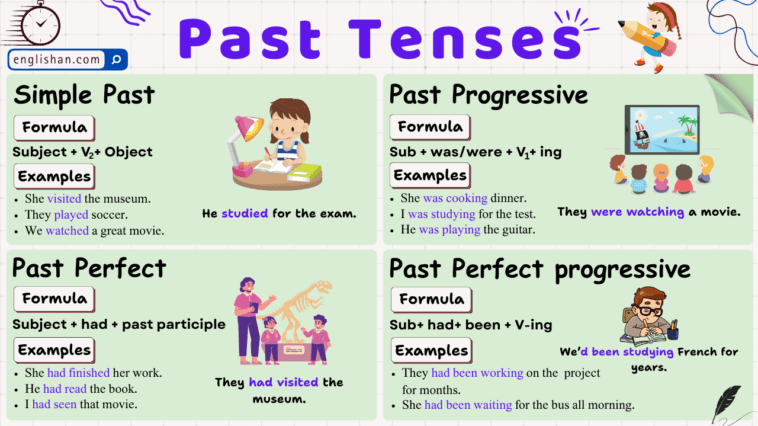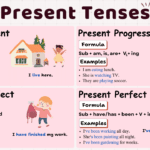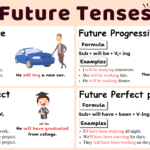Throughout this section of the course, you’ll gain comprehensive insights into the English present tense. The present tense in English comprises the following:
In this article, we’re going to learn about all the types of past tense. You’ll get a clear idea of when and how to use each one. There are also exercises to help you practice and understand these tenses better.
What Are Tenses?
Tenses in grammar indicate the time of an action. There are three main types: past, present, and future.
| Present | Past | Future | |
| Simple | I watch TV every evening. | I watched TV yesterday. | I will watch TV tomorrow. |
| Continuous | I am watching TV right now. | I was watching TV when the phone rang. | I will be watching TV at 8 PM tomorrow. |
| Perfect | I have watched TV already today. | I had watched TV before bedtime. | I will have watched TV by 9 PM. |
| Perfect Continuous | I have been watching TV for an hour. | I had been watching TV for two hours when you called. | By 10 PM tomorrow, I will have been watching TV for three hours. |

Simple Past Tense
The simple past tense is used to describe completed actions or events that happened at a specific point in the past. In English, regular verbs form the past tense by adding “-ed” to the base form, while irregular verbs follow different patterns.
Formation of Simple Past Tense
- Subject + verb(2nd form) + object.
- Subject + did not + verb(1st form) + object.
- Did + subject + verb (1st form) + object?
In any of the tenses, you can form positive, negative, or interrogative (a question) sentences.
| Person | Positive | Negative | Question |
|---|---|---|---|
| I | I played soccer. | I did not play soccer. | Did I play soccer? |
| You | You played soccer. | You did not play soccer. | Did you play soccer? |
| We | We played soccer. | We did not play soccer. | Did we play soccer? |
| They | They played soccer. | They did not play soccer. | Did they play soccer? |
| He | He played soccer. | He did not play soccer. | Did he play soccer? |
| She | She played soccer. | She did not play soccer. | Did she play soccer? |
| It | It played soccer. | It did not play soccer. | Did it play soccer? |
This table uses the sentence “I play soccer” as a base for illustrating positive, negative, and question sentences in the Present Simple tense.
Uses of Simple Past Tense:
The past tense is a verb form used to indicate an action or state that took place in the past. Here are some common uses of the past tense with examples:
- Completed Actions:
- Example: “She finished her homework before dinner.”
- Sequential Actions in the Past:
- Example: “I woke up, had breakfast, and then went to work.”
- Habits or Routines in the Past:
- Example: “We always went for a walk after dinner.”
- Events in a Story:
- Example: “Once upon a time, there was a magical kingdom.”
- Past Facts or General Truths:
- Example: “Abraham Lincoln was the 16th President of the United States.”
- Expressions of Duration:
- Example: “I lived in Paris for three years.”
- Conditions in the Past:
- Example: “It was a sunny day yesterday.”
- States or Situations in the Past:
- Example: “She was excited about the upcoming trip.”
- Polite Requests:
- Example: “Could you pass me the salt, please?”
- Reported Speech:
- Example: “He said he would come to the party.”
The past continuous tense is used to describe actions that were ongoing or in pro
Past Continuous Tense
The past continuous tense describes an ongoing action in the past. It is formed with the past tense of “to be” (was/were) and the present participle (-ing form) of the main verb. Example: “She was reading a book when the phone rang.”
Formation of Past Continuous Tense
- Subject + was/were + verb(1st form) ing + object.
- Subject + was/were + not + verb(1st form) ing + object.
- Was/Were + subject + verb (1st form) ing + object?
In any of the tenses, you can form positive, negative, or interrogative (a question) sentences.
| Person | Positive | Negative | Question |
|---|---|---|---|
| I | I was eating. | I was not eating. | Was I eating? |
| You | You were eating. | You were not eating. | Were you eating? |
| We | We were eating. | We were not eating. | Were we eating? |
| They | They were eating. | They were not eating. | Were they eating? |
| He | He was eating. | He was not eating. | Was he eating? |
| She | She was eating. | She was not eating. | Was she eating? |
| It | It was eating. | It was not eating. | Was it eating? |
The past continuous tense is formed by using the past tense of the verb “to be” (was/were) and the present participle (base verb + -ing). It is used to describe actions that were ongoing or in progress at a specific point in the past.
Uses of Past Continuous Tense with Examples
The past continuous tense is used to describe actions that were ongoing or in progress at a specific point in the past. Here are some common uses of the past continuous tense with examples:
- Ongoing Actions in the Past:
- Example: “At 3 PM yesterday, I was studying for my exams.”
- Interrupted Actions:
- Example: “She was watching TV when the phone rang.”
- Parallel Actions:
- Example: “While they were playing outside, I was cooking dinner.”
- Describing Atmosphere or Background:
- Example: “It was raining heavily, and thunder was rumbling in the distance.”
- Polite Inquiries or Offers:
- Example: “I was wondering if you could help me with my homework.”
- Expressing Duration:
- Example: “They were talking for hours before I joined them.”
- Expressions of Irritation or Annoyance:
- Example: “He was constantly interrupting me during the meeting.”
- Setting the Scene in a Story:
- Example: “The sun was setting as they walked along the beach.”
Past Perfect Tense
The past perfect tense is used to indicate an action completed before another action or event in the past. It is formed by using the past tense of the auxiliary verb “to have” (had) and the past participle of the main verb.
Formation of Past Perfect Tense
- Subject + had + verb(3rd form) + object.
- Subject + had + not + verb(3rd form) + object.
- Had + subject + verb (3rd form) + object?
In any of the tenses, you can form positive, negative, or interrogative (a question) sentences.
| Person | Positive | Negative | Question |
|---|---|---|---|
| I | I had worked. | I had not (hadn’t) worked. | Had I worked? |
| You | You had worked. | You had not (hadn’t) worked. | Had you worked? |
| We | We had worked. | We had not (hadn’t) worked. | Had we worked? |
| They | They had worked. | They had not (hadn’t) worked. | Had they worked? |
| He | He had worked. | He had not (hadn’t) worked. | Had he worked? |
| She | She had worked. | She had not (hadn’t) worked. | Had she worked? |
| It | It had worked. | It had not (hadn’t) worked. | Had it worked? |
The past perfect tense is used to express an action that was completed before another action took place in the past. The structure involves the past perfect form of the auxiliary verb “to have” (had) and the past participle of the main verb.
Uses of Past Perfect Tense with Examples
The past perfect tense is used to indicate an action that was completed before another action or event in the past. Here are some common uses of the past perfect tense with examples:
- Sequential Actions in the Past:
- Example: She had already finished her work when the boss arrived.
- Actions Before a Specific Time in the Past:
- Example: They had visited the museum before it closed.
- Events in a Story (Flashback):
- Example: He remembered that he had left his keys at home.
- Expressing Regret or Unfulfilled Conditions:
- Example: I wish I had known about the traffic; I would have left earlier.
- Reported Speech:
- Example: She said she had never been to Asia.
- Expressing Cause and Effect in the Past:
- Example: Because they had studied hard, they performed well in the exam.
- Conditional Sentences (Type 3 – Unreal Past Situations):
- Example: If I had seen the warning sign, I wouldn’t have taken that road.
- Contrasting Two Past Actions:
- Example: He had never seen such a beautiful sunset before he visited the beach.
Past Perfect Continuous Tense
The past perfect continuous tense is used to express a continuous action that was ongoing and had been happening for a period of time before another action or event in the past. It is formed by using the past perfect tense of the auxiliary verb “to have” (had), the past participle of the main verb “to be” (been), and the present participle (base verb + -ing).
Formation of Past Perfect Continuous Tense
- Subject + had been + verb(1st form) ing + object + since/for.
- Subject + had + not + been + verb(1st form) ing + object + since/for.
- Had + subject + been + verb (1st form) ing + object + since/for?
In any of the tenses, you can form positive, negative, or interrogative (a question) sentences.
| Positive | Negative | Question | |
|---|---|---|---|
| I | I had been working for two hours. | I had not (hadn’t) been working for two hours. | Had I been working for two hours? |
| You | You had been working since morning. | You had not (hadn’t) been working since morning. | Had you been working since morning? |
| We | We had been working for the entire week. | We had not (hadn’t) been working for the entire week. | Had we been working for the entire week? |
| They | They had been working since the last meeting. | They had not (hadn’t) been working since the last meeting. | Had they been working since the last meeting? |
| He | He had been working since yesterday. | He had not (hadn’t) been working since yesterday. | Had he been working since yesterday? |
| She | She had been working for three hours. | She had not (hadn’t) been working for three hours. | Had she been working for three hours? |
| It | It had been working since last month. | It had not (hadn’t) been working since last month. | Had it been working since last month? |
In the examples above, for is used to indicate the duration of the action, and since is used to specify the starting point of the action. This helps provide additional information about the timeframe in which the continuous action occurred in the past.
Uses of Past Perfect Continuous Tense with Examples
The past perfect continuous tense is used to express the duration of an ongoing action that was happening before another action or event in the past. Here are some common uses of the past perfect continuous tense with examples:
- Duration Leading Up to Another Point in the Past:
- Example: “She was out of breath because she had been running.”
- Emphasizing the Continuous Nature of an Activity:
- Example: “They were exhausted because they had been working on the project for hours.”
- Events or Actions That Were Ongoing Before a Specific Time in the Past:
- Example: “He was tired when he arrived because he had been driving all night.”
- Contrasting Two Past Actions:
- Example: “She was very fit because she had been exercising regularly.”
- Actions That Were Ongoing Up to a Point in the Past:
- Example: “They had been living in the city for five years before they decided to move.”
- Expressing Cause and Effect in the Past:
- Example: “The road was wet because it had been raining.”
- Expressing Regret or Unfulfilled Conditions:
- Example: “I apologize; I hadn’t been paying attention to what you were saying.”
- Setting the Scene or Providing Background Information:
- Example: “The garden was in full bloom because it had been receiving plenty of sunlight.”
Quiz:
- Yesterday, she ________ (eat/ate) a delicious cake.
- While I ________ (watching/watched) TV, the power went out.
- By the time we arrived, the movie ________ (start/started).
- They ________ (play/played) tennis when it started raining.
- I ________ (study/studied) for hours before the exam. a) study b) studied
- When the teacher entered, the students ________ (talked/talking).
- By 6 o’clock, they ________ (complete/completed) the project.
- We ________ (live/lived) in Paris for three years before moving to London.
- She ________ (cook/cooked) dinner when the guests arrived.
- They ________ (waited/wait) for the bus for an hour.
- By the time I reached the station, the train ________ (leave/left).
- While I ________ (read/reading) a book, my phone rang.
- The children ________ (play/playing) outside all day yesterday.
- I ________ (not see/did not see) you at the party last night.
- She ________ (sleep/slept) for only two hours before the big presentation.
- When I arrived, they ________ (already/just) finished dinner.
- Before she moved to the city, she ________ (never/ever) experienced public transportation.
- They ________ (travel/traveled) to Europe twice last year.
- By the time we got to the concert, the band ________ (already/just) started playing.
- While I ________ (walk/walking) in the park, I saw a beautiful rainbow.
Answers:
- ate
- watching
- started
- played
- studied
- talked
- completed
- lived
- cooked
- waited
- left
- read
- played
- did not see
- slept
- already
- never
- traveled
- already
- walk
FAQS:
1. How is the Simple Past Tense formed for regular verbs?
For regular verbs, the past tense is formed by adding “-ed” to the base form.
2. How is the Past Continuous Tense formed?
Form the past tense of “to be” (was/were) + the present participle (verb + “-ing”).
3. What does the Past Perfect Tense indicate?
The Past Perfect Tense indicates an action completed before another action in the past.
4. How is the Past Perfect Tense formed?
Form the past tense of “to have” (had) + the past participle of the main verb.
5. When is the Past Perfect Continuous Tense used?
The Past Perfect Continuous Tense describes actions that were ongoing before another action in the past.
6. How is the Past Perfect Continuous Tense formed?
Use the past perfect of “to have” (had) + been + the present participle (verb + “-ing”).
Get Printable Worksheets on English Tenses and Check Your Understanding
- Tenses Chart With Examples, Rules, Usage
- Present Tenses With Examples, Rules, Usage
- Past Continuous Tense Worksheets
- Past Perfect Tense Worksheets
- Past Perfect Continuous Worksheets
- Present Perfect Continuous Worksheets



